Leo Frank Centennial 100 Years Ago, the Conclusion of The Coroner’s Inquest in the Mary Phagan Murder Mystery
Posted By simmons on May 8, 2015


The Coroner's Inquest
Presided over by the Fulton County Coroner Paul V. Donehoo were a half-petite jury of prominent men from the community, who opened the coroner's inquest investigation on Wednesday morning, April 30, 1913.
The coroner's inquest began shortly after nine o'clock after the jury was sworn under oath. The empaneled tribunal in total consisted of seven men (1 + 6), the coroner and six inquest jurymen: (1.) H. Ashford, foreman, (2.) Glenn Dewberry, (3.) J. Hood, (4.) C. Langford, (5.) John Miller, (6.) C. Sheats, (7.) Judge of the Inquest Jury, The Fulton County Coroner, Paul Donehoo.
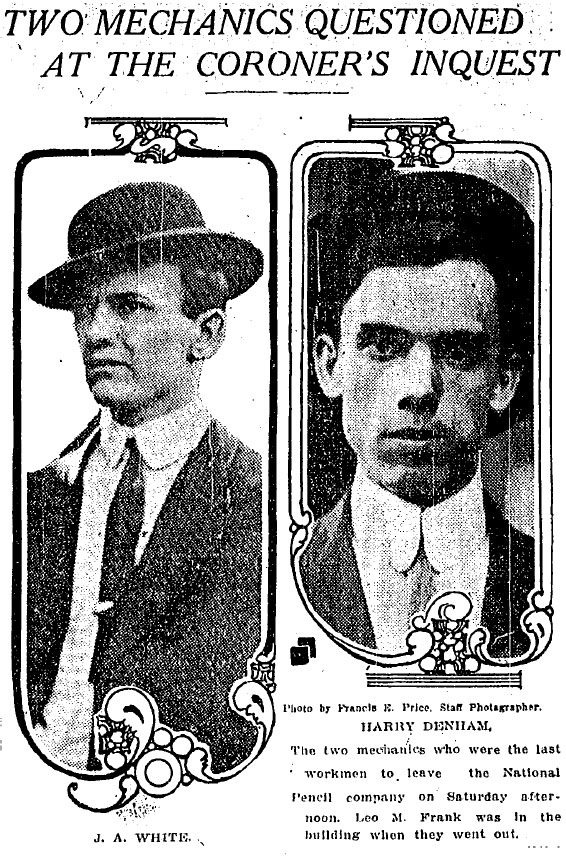
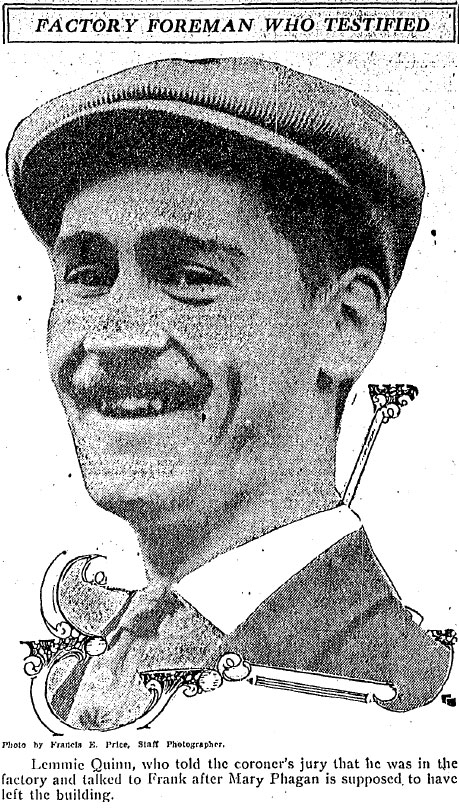
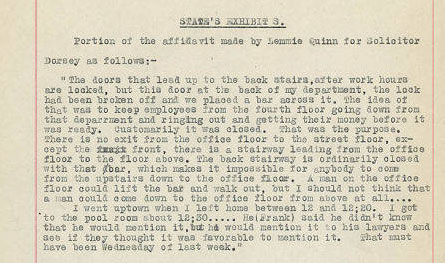
Caught in a Lie: The Perjury of Lemmie A. Quinn
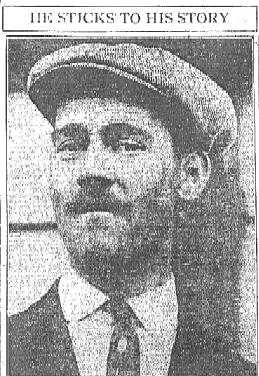 A controversial new development occurred concerning Leo M. Frank's murder timeline alibi about him never leaving his office on April 26, 1913, between noon and 12:45 p.m. Leo Frank said he had forgotten for the first week of the murder investigation to bring forward Lemmie A. Quinn, foreman of the metal room, a key witness at the coroner's inquest and later at the Frank trial. He was criminally impeached during the appeals after the revelation that he was offering bribes to witnesses to change their stories. At the coroner's inquest, Lemmie Quinn came forward to provide testimony that sounded contrived and did not pass the common sense test.
A controversial new development occurred concerning Leo M. Frank's murder timeline alibi about him never leaving his office on April 26, 1913, between noon and 12:45 p.m. Leo Frank said he had forgotten for the first week of the murder investigation to bring forward Lemmie A. Quinn, foreman of the metal room, a key witness at the coroner's inquest and later at the Frank trial. He was criminally impeached during the appeals after the revelation that he was offering bribes to witnesses to change their stories. At the coroner's inquest, Lemmie Quinn came forward to provide testimony that sounded contrived and did not pass the common sense test.
Quinn told the coroner's inquest jury, he had went back to the pencil factory and specifically into Leo M. Frank's office at 12:20 to 12:25 to talk about a baseball bet with Mr. Herbert George Schiff, but Schiff was not supposed to be at the factory at all that day because it was a state holiday and everyone was given the day off.
Herbert G. Schiff later prided himself at the Leo Frank trial for never missing a day of work in five years (BOE, Herbert Schiff, 1913) except once unintentionally during a disastrous flood. Leo Frank gave the false impression that Schiff missed work that day to support the Quinn appearance.
Several employees close to Leo Frank would later provide a cacophony of contradictory information about Schiff.
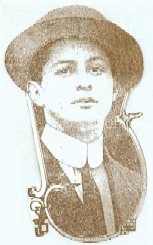 The young Herbert G. Schiff became the superintendent at the NPCo after Leo Frank.
The young Herbert G. Schiff became the superintendent at the NPCo after Leo Frank.The coroner's inquest jury saw right through it, and ostensibly the falsified testimony of Quinn was meant to shrink the plausible time Leo M. Frank would have to bludgeon, rape, and strangle Mary Phagan by fifteen minutes from formerly 12:02 p.m. to 12:35 p.m., to 12:02 p.m. to 12:19 p.m. However, the importance of Lemmie A. Quinn's manufactured testimony was it added eyewitness testimony strength to Leo Frank's alibi that he never left his office from at least noon to 12:35 p.m.
Lemmie Quinn's perjury shrunk Leo M. Frank's unaccounted time on that fateful Saturday, but it still left the time frame Mary Phagan arrived at Frank's office wide open and unaccounted for.
Three Separate and Distinct Mary Phagan Arrival Times Would Later Become Four
According to Leo Frank:
1. Mary Phagan arrived in his second-floor business office at 12:03 p.m. on April 26, 1913--this information was given to detectives on Sunday, April 27, 1913, in Leo Frank's office.
2. Mary Phagan arrived in his second-floor business office at "12:05 pm and 12:10 p.m., maybe 12:07 p.m." according to Leo Frank in State's Exhibit B, given to the police on Monday, April 28, 1913.
3. Mary Phagan arrived in his second-floor business office at 12:10 p.m. on April 26, 1913--Frank gave this information at the coroner's inquest.
At the time of the coroner's inquest, Leo Frank had provided three different times that Mary Phagan had arrived in his office.
Conclusion of the Coroner's Inquest and Jury
Coroner Paul Donehoo and his inquest jury of six men empaneled, questioned over one hundred factory employees and dozens of other various associated people.
The coroner's inquest combed through the factory to examine the layout and permutations of the murder.
The weeklong inquest and testimony provided under oath left strong suspicion directed upon Leo M. Frank when Thursday, May 8, 1913, the Mary Phagan Inquest drew to a close.
At 6:30 p.m., the jury went into executive session to hear the testimony of Dr. J. W. Hurt, county physician, on the what had happened to Mary Phagan shortly before her death and what was the likely cause. The doctor addressed the jury for twenty minutes.
Donehoo convened to hear the jury findings:
"We, the coroner's jury, empaneled and sworn by Paul Donehoo, coroner of Fulton County, to inquire into the death of Mary Phagan, whose dead body now lies before us, after having heard the evidence of sworn witnesses, and the statement of Dr. J. W. Hurt, County Physician, find that the deceased came to her death from strangulation. We recommend that Leo M. Frank and Newt Lee be
held under charges of murder for further investigation by the Fulton County grand jury.
(signed)
Homer C. Ashford, Foreman
Dr. J. W. Hurt, County Physician"
Coroner and Inquest Jury Verdict: The Coroner Approved the Unanimous Finding of the Inquest Jury
The coroner and his inquest jury of six men together voted unanimously 7 to 0 recommending Leo M. Frank be bound over for murder and investigated further by a grand jury of twenty-three men, which ironically included four Jews.
Coroner Paul Donehoo ordered that Leo Frank be bound over for murder and Newt Lee was to be held as a material witness.
Still yet to be uncovered was who wrote the murder notes that appeared to be written by a Negro in Ebonics.
Police Delivered the News to Leo Frank and Newt Lee
Deputy Plennie Minor delivered the unanimous verdict of the coroner's inquest jury to Leo M. Frank, who was being held in the infamous Atlanta Police Tower. Frank was sitting perusing a local daily newspaper, Atlanta Constitution, May 8, 1913, at the time at the time of the message. When Deputy Plennie Minor approached Leo M. Frank and told him about the unanimous verdict of the inquest jury, which had ordered that Frank be held for murder and for a more thorough investigation by the grand jury.
Newt Lee slumped his head dejectedly when the bad news was delivered to him. However, Leo Frank insolently replied that it was no more than he had expected and continued crackling away and folding the big sheets of his newspaper.
In total, more than two hundred witnesses, factory workers, and affiliates had been subpoenaed providing sworn testimony at the Inquest.
What stood out the most from all the inquest testimony was that Leo Frank specified he never went to the bathroom that day, and he held onto that position for 3.5 months until he made a startling revelation during his trial on August 18, 1913.
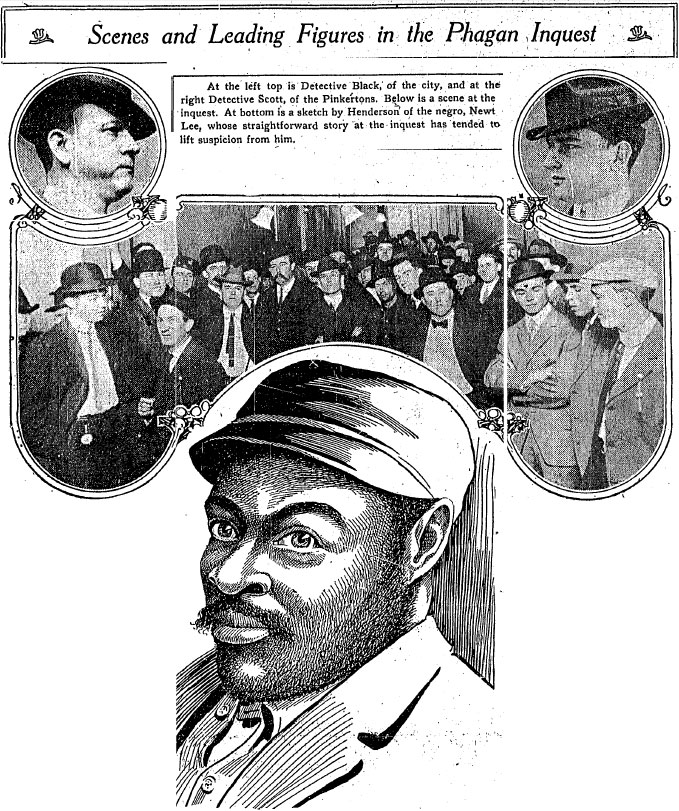
The ace up Dorsey's sleeve for the grand jury investigation, Monteen Stover.
NEXT: Leo Frank Grand Jury Indictment on Saturday, May 24, 1913.
References:
Atlanta Georgian Newspaper Coverage of the Mary Phagan Murder Investigation, Coroner's Inquest Testimony of Leo Frank, May, 5, 8, 1913: http://leofrank.org/library/atlanta-georgian/.
The Frank Case (1913). The Inside Story of Georgia's Greatest Murder Mystery. Atlanta Publishing Company, Atlanta, GA. The first book ever published on the Leo Frank case. http://leofrank.org/library/frank-case.pdf.
May 1, 1913, Mary Phagan and Leo Frank Coroner's Inquest, Atlanta Constitution: http://www.leofrank.org/library/atlanta-journal-constitution/frank-tried-to-flirt-with-murdered-girl-says-her-boy-chum-may-1-1913.pdf.
May 9, 1913, Atlanta Constitution.
Atlanta Constitution, The Second Coroner's Inquest Session,
http://www.leofrank.org/library/atlanta-journal-constitution/frank-and-lee-ordered-held-by-coroners-jury-for-mary-phagan-murder-may-9-1913.pdf.
- Christian Anti-Defamation League: "Bashing" [Last Updated On: January 21st, 2016] [Originally Added On: May 16th, 2011]
- ADL Calls For "Major Law Enforcement Operaton" to Deal with Obamacare Critics 1/2 [Last Updated On: January 21st, 2016] [Originally Added On: May 17th, 2011]
- Leo Frank and the Founding of the ADL, Anti-Defamation League of B'nai B'rith [Last Updated On: January 4th, 2020] [Originally Added On: May 22nd, 2011]
- Anti-Defamation League Warns of 'lone Wolves' [Last Updated On: May 22nd, 2011] [Originally Added On: May 22nd, 2011]
- Anti-Defamation League Protest [Last Updated On: May 24th, 2011] [Originally Added On: May 24th, 2011]
- re: anti-defamation league warns of 'lone wolves' [Last Updated On: May 24th, 2011] [Originally Added On: May 24th, 2011]
- Anti-Defamation League ADL Part 4 [Last Updated On: May 30th, 2011] [Originally Added On: May 30th, 2011]
- Alex Jones Talks About The ADL Attacking Him [Last Updated On: January 21st, 2016] [Originally Added On: May 30th, 2011]
- Secretary Napolitano at the Anti-Defamation League Leadership Conference 4/22/09 [Last Updated On: May 31st, 2011] [Originally Added On: May 31st, 2011]
- Anti Defamation league [Last Updated On: January 21st, 2016] [Originally Added On: May 31st, 2011]
- Alex Details ADL's Latest Attack on Him and Other Patriots on Alex Jones Tv 1/2 [Last Updated On: January 21st, 2016] [Originally Added On: May 31st, 2011]
- disclose Anti Defamation League ADL 7 Video [Last Updated On: June 3rd, 2011] [Originally Added On: June 3rd, 2011]
- Anti-Defamation League - Interfaith Mission [Last Updated On: June 3rd, 2011] [Originally Added On: June 3rd, 2011]
- Closing Arguments of Frank Hooper against Brooklyn Jew Leo Frank August 21, 1913 [Last Updated On: January 21st, 2016] [Originally Added On: June 4th, 2011]
- Leo Frank Case 1913: Frank Hooper Closing Arguments for State of Georgia vs. Leo Frank charged with the Murder of Mary Phagan [Last Updated On: June 4th, 2011] [Originally Added On: June 4th, 2011]
- Anti-Defamation league calls David Dees 'conspiratorial artist' [Last Updated On: June 7th, 2011] [Originally Added On: June 7th, 2011]
- William Cooper - The Ugly Truth About the Anti-Defamation League #2 (Full Length) [Last Updated On: January 21st, 2016] [Originally Added On: June 15th, 2011]
- ADL Calls For "Major Law Enforcement Operaton" to Deal with Obamacare Critics 2/2 [Last Updated On: January 21st, 2016] [Originally Added On: June 17th, 2011]
- William Cooper - The Ugly Truth About the Anti-Defamation League #4 (Full Length) [Last Updated On: June 20th, 2011] [Originally Added On: June 20th, 2011]
- REICH PROPAGANDIST REPORTED AS "A PUBLIC DANGER" BY ANTI-DEFAMATION LEAGUE [Last Updated On: January 21st, 2016] [Originally Added On: June 21st, 2011]
- William Cooper The Ugly Truth About the Anti Defamation League #2 Full Length [Last Updated On: June 26th, 2011] [Originally Added On: June 26th, 2011]
- William Cooper The Ugly Truth About the Anti Defamation League #1 Full Length [Last Updated On: January 21st, 2016] [Originally Added On: June 28th, 2011]
- The Racist Anti-Semitic Murder of Jewish Factory Boss Leo Frank [Last Updated On: January 21st, 2016] [Originally Added On: July 10th, 2011]
- The Murder of an Innocent Jew [Last Updated On: July 10th, 2011] [Originally Added On: July 10th, 2011]
- The Anti-Defamation League of B'nai B'rith by Dr. William Pierce 1/2 [Last Updated On: July 12th, 2011] [Originally Added On: July 12th, 2011]
- David Icke - ADL, Zionism and The House of Rothschilds need to be exposed [Last Updated On: January 21st, 2016] [Originally Added On: July 17th, 2011]
- William Cooper The Ugly Truth About the Anti Defamation League 5 Full Length [Last Updated On: January 21st, 2016] [Originally Added On: July 23rd, 2011]
- Cadeflaw Advocates 2010 [Last Updated On: January 21st, 2016] [Originally Added On: August 1st, 2011]
- August 17, 1915: The Only Jew Lynched in North American History [Last Updated On: January 21st, 2016] [Originally Added On: August 17th, 2011]
- Anti-Semitism August 17, 1915, the only lynching of a Jew in USA history. Leo M. Frank gets lynched by a Mob. [Last Updated On: August 17th, 2011] [Originally Added On: August 17th, 2011]
- James Baldwin and Dick Gregory: "Baldwin's Nigger" (1969) - Video [Last Updated On: August 25th, 2011] [Originally Added On: August 25th, 2011]
- Anti-Defamation League Calling For Helen Thomas Suicide Or Death [Last Updated On: January 21st, 2016] [Originally Added On: August 26th, 2011]
- The Anti-Defamation League of B'nai B'rith Born in the Murder Trial of Pedophile Rapist Leo Frank [Last Updated On: January 21st, 2016] [Originally Added On: August 26th, 2011]
- The 1913 Murder Trial that resulted in the Birth of the Anti-Defamation League of B'nai B'rith [Last Updated On: August 26th, 2011] [Originally Added On: August 26th, 2011]
- William F. Buckley Gives Muhammad Ali His Props (December 12, 1968) - Video [Last Updated On: September 3rd, 2011] [Originally Added On: September 3rd, 2011]
- Alicia Bleier of the Anti-Defamation League on Larry King murder trial [Last Updated On: January 21st, 2016] [Originally Added On: September 3rd, 2011]
- Driven by a mission [Last Updated On: September 14th, 2011] [Originally Added On: September 14th, 2011]
- FB 4.5: Simple Android app - Run Configuration - desktop adl [Last Updated On: September 24th, 2011] [Originally Added On: September 24th, 2011]
- ADL Calls For "Major Law Enforcement Operaton" to Deal with Obamacare Critics 1/2 [Last Updated On: September 25th, 2011] [Originally Added On: September 25th, 2011]
- ADL Jews Want To Talk To Farrakhan [Last Updated On: September 28th, 2011] [Originally Added On: September 28th, 2011]
- Tell the ADL to go to Hell [Last Updated On: January 21st, 2016] [Originally Added On: September 28th, 2011]
- Anti-Defamation League - Security Skills [Last Updated On: September 30th, 2011] [Originally Added On: September 30th, 2011]
- William Pierce on the ADL 1/2 [Last Updated On: January 21st, 2016] [Originally Added On: October 7th, 2011]
- ADL Exposed: (Anti Defamation League) A Zionist Propaganda and Fake Agency [Last Updated On: October 10th, 2011] [Originally Added On: October 10th, 2011]
- Anti-Defamation League Calling For Helen Thomas Suicide Or Death - Video [Last Updated On: October 15th, 2011] [Originally Added On: October 15th, 2011]
- Slemany Adl Aziz Bo Medane Azade Slemany 2011 - Video [Last Updated On: January 21st, 2016] [Originally Added On: October 16th, 2011]
- ADL attacks me, how desperate and pathetic they must be - Video [Last Updated On: January 21st, 2016] [Originally Added On: October 16th, 2011]
- Anti Defamation league - Video [Last Updated On: October 17th, 2011] [Originally Added On: October 17th, 2011]
- ADL Calls For "Major Law Enforcement Operaton" to Deal with Obamacare Critics 2/2 - Video [Last Updated On: October 18th, 2011] [Originally Added On: October 18th, 2011]
- Muhammad Ali interviewed by Howard Cosell (Nov. 4, 1974) - Video [Last Updated On: October 19th, 2011] [Originally Added On: October 19th, 2011]
- William Cooper - The Ugly Truth About the Anti-Defamation League #1 (Full Length) - Video [Last Updated On: October 20th, 2011] [Originally Added On: October 20th, 2011]
- Control Resistance "Declaration" - Video [Last Updated On: January 21st, 2016] [Originally Added On: October 20th, 2011]
- Muhammad Ali Interview with Ian Wooldridge (1969) - Video [Last Updated On: January 21st, 2016] [Originally Added On: October 21st, 2011]
- ISRAEL - The Promised Land of Organized Crime - Video [Last Updated On: January 21st, 2016] [Originally Added On: October 24th, 2011]
- William Cooper The Ugly Truth About the Anti Defamation League #2 Full Length - Video [Last Updated On: January 21st, 2016] [Originally Added On: October 27th, 2011]
- Farah Calls Ted Pike a Lying Anti-Semite (Oct 2011) - Video [Last Updated On: October 31st, 2011] [Originally Added On: October 31st, 2011]
- Speach02(Dr. Bounthone Chanthalavong- Wiese) - Video [Last Updated On: January 21st, 2016] [Originally Added On: November 6th, 2011]
- Defamation - Video [Last Updated On: January 21st, 2016] [Originally Added On: November 21st, 2011]
- Defamation - ADL bullying Ukraine into downplaying the Holodomor as serious as the Holocaust - Video [Last Updated On: November 23rd, 2011] [Originally Added On: November 23rd, 2011]
- Rabbi David Komerofsky Testimonial - 2010 ADL Austin Torch of Liberty Award Dinner - Video [Last Updated On: November 30th, 2011] [Originally Added On: November 30th, 2011]
- The Illustrated Protocols Of Zion - Video [Last Updated On: December 11th, 2011] [Originally Added On: December 11th, 2011]
- William Pierce on the ADL 1/2 - Video [Last Updated On: December 26th, 2011] [Originally Added On: December 26th, 2011]
- Mosque at Ground Zero: That's Bullshit - Video [Last Updated On: January 6th, 2012] [Originally Added On: January 6th, 2012]
- Michelle Monaghan and Alice Eve ADL Entertainment Industry Awards Arrivals - Video [Last Updated On: January 15th, 2012] [Originally Added On: January 15th, 2012]
- Has Jewry Infiltrated The Local Police? - Video [Last Updated On: January 20th, 2012] [Originally Added On: January 20th, 2012]
- ADL 122 - Lotte e Duri Armenti - Video [Last Updated On: January 25th, 2012] [Originally Added On: January 25th, 2012]
- Jew(s) Against the Anti-Defamation League - Video [Last Updated On: February 8th, 2012] [Originally Added On: February 8th, 2012]
- Controversial Former News Anchor Speaks To ADL - Video [Last Updated On: January 21st, 2016] [Originally Added On: February 11th, 2012]
- A Tribute to the ADL - Video [Last Updated On: January 21st, 2016] [Originally Added On: February 15th, 2012]
- Who's Behind The Firing Of Pat Buchanan? - Video [Last Updated On: February 23rd, 2012] [Originally Added On: February 23rd, 2012]
- ADL condemns upcoming Oakland talk by ‘hate-mongering’ activist [Last Updated On: January 21st, 2016] [Originally Added On: February 23rd, 2012]
- Adolf HITLER Shampoo Commercial for Biomen - Video [Last Updated On: March 26th, 2012] [Originally Added On: March 26th, 2012]
- The Anti-Defamation League A Day of Difference - Video [Last Updated On: March 26th, 2012] [Originally Added On: March 26th, 2012]
- Whole Foods Market - Anti Defamation League - Video [Last Updated On: January 21st, 2016] [Originally Added On: May 25th, 2012]
- Anti-Defamation (2/4) - Video [Last Updated On: June 16th, 2012] [Originally Added On: June 16th, 2012]
- Anti-Defamation League Responds To Oak Creek Temple Shooting - Video [Last Updated On: August 7th, 2012] [Originally Added On: August 7th, 2012]
- High School Interns Learn How To Combat Prejudice [Last Updated On: August 16th, 2012] [Originally Added On: August 16th, 2012]
- Who Exactly Owns The Media 2012? - Video [Last Updated On: October 24th, 2012] [Originally Added On: October 24th, 2012]
- Egypt prayer for destruction of Israel - Video [Last Updated On: October 27th, 2012] [Originally Added On: October 27th, 2012]
- ADL Behind The Scenes - Video [Last Updated On: January 21st, 2016] [Originally Added On: October 31st, 2012]
Comments